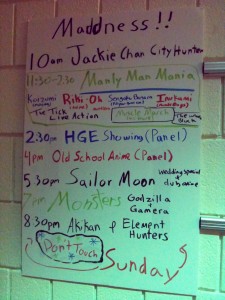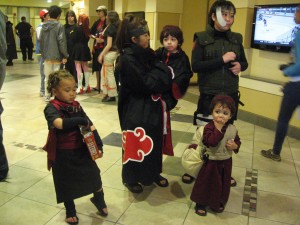Blogger’s/Translator’s introduction: This is the followup post to an earlier translation of 30-year veteran animator and director Yamasaki Osamu‘s blog post regarding the financial situation of the animation industry and animators in specific. Again, this post was originally posted on his blog on the JAniCA (Japan Animation Creators Association) website. Again, I would like to thank Yamasaki-san and Nekomiya-san from JAniCA for allowing me to translate and post the following article.
—————
It seems like some people misunderstood my previous post about the disastrous situation going on with new animators, and thought that everyone involved in anime production is in the same situation, but the situation isn’t that miserable… at least, that’s how I feel.
To put it better, whether you’re someone making a decent living or if you’re someone sliding into poverty, two groups of people who coexist in the anime industry, depends on what department you’re working in, not your experience or your accomplishments… would be the way to put it.
I wrote that if you halved the unit price paid per drawing for painters, then inbetweeners could make a living. However, if you wanted to adjust the budget in other ways, I can come up with a lot of ways to do it.
I’m not sure if I should write something like this in a place like this, but… In the anime industry right now, production supervisors, the people that ought to know how to allocate a budget, have no idea what’s actually going on in the studios. As a result, I think that this is causing the state of the industry to grow worse and worse.
And so… I’ll take it upon myself to say this here:
“A lot of anime production staff are making plenty of money!!”
“What’s more, all that’s needed to save inbetweeners is 500,000 yen ($5,500 usd) an episode from a 10 million yen ($112,000) TV series episode budget!”
How much money is needed to raise the unit cost for an inbetweener from 200 to 300 yen? How much are we missing? An average episode uses 4000-5000 in-between frames. Looking at those numbers, how short are we falling? All you need is 500,000 yen an episode to give this raise.
Is it really not possible to raise this amount of money?
Last time, I wrote about reducing the unit cost for painters, but I think there are plenty of other places where you can find the money.
To give one example that I’m aware of, let’s look at sound director pay.
A sound director for a TV series makes an average of 150,000-180,000 yen ($1,675-$2000) an episode.
The director for the same episode makes 200,000-250,000 yen ($2,200-2,800).
The animation director makes around 300,000 yen ($3,350).
On first glance, these numbers might look fair, but in reality, that’s not the case at all. I wrote about this last time, but an animation director is bound for about a month and a half to the job he’s paid 300,000 yen for, so that comes out to making around 200,000 yen a month.
For directors, it might take six months preparation to begin work on a 25-26 episode (half-year) series, so you could calculate their monthly pay to be about 500,000 yen ($5,600).
In comparison, a sound director takes two days to complete an episode, including preparation time. Therefore, a lot of sound directors work on 2-3 titles at a time, for a total of 3 episodes a week. Taking on 12 episodes a month isn’t hard or uncommon.
Monthly pay: 150,000 yen x 12 episodes = 1,800,000 yen ($20,000).
Sound directors who make over 20,000,000 yen ($223,000) a year are common.
As for scenario writers, they make around 180,000 yen ($2,000) a script and work on 2-3 at a time, but unlike sound directors, it’s fairly unheard of to write a completed script in 2 days. We can say that they finish an average of 1-2 scripts in an average month, putting their monthly income from manuscript fees at about 300,000 ($3,350) yen.
Whether you think this is a lot or a little, depending on the show ((tl note: I think this means “if it gets a dvd”)), a writer may be paid script royalties if the work becomes a hit, making millions of yen without doing any extra work. Since one could be working on three or more shows each month, the chances that a writer will write a script for a hit series increases.
As a result, a writer who does proper work would reach 10 million yen ($110,000) a year.
Of course, there are writers who make more, and I’m sure there are writers who don’t make this much.
One thing you can definitely say, though, is that a series becoming a hit or not isn’t necessarily linked to the quality of the script.
Besides these examples, 800,000-1,000,000 yen (~$9,000-$11,000) an episode is allotted to cinematography an episode. A cinematography team is made up of 4-5 people, and complete one TV episode in 3-4 days.
Aside from this, other “sentori” jobs for the team such as inbetween photography, keyframe photography, and storyboard photography ((these are used during recording sessions)) may arise if there isn’t tight control on the schedule, and these jobs are included in the pay.
Even so, the 4-5 person team ends up making a total of 4 million yen or more a month. ($44,500)
Looking at the numbers I’ve written above, you could conceivably compare the level of each section’s pay to the average in other industries and say something like “Well… around 20 million yen a year seems normal.” After all, that’s around what the salaried employees at the TV stations and the ad agencies make, so people involved in anime making that much doesn’t seem too strange.
However, when you think what it takes to actually produce a given anime, how much does each of these groups contribute? How much should each section really be paid?
I think that producers ought to think about these things.
Aren’t sound directors being paid too much?
If you’re going to pay screenwriters royalties, do you really need to also pay guarantees?
Do you really have to pay so much to low-level writers whose involvement amounts to being middlemen for the person doing series composition?
Aren’t cinematographers being given extra work because production managers are careless?
And while I’m at it, “Animation directors are even worse off than inbetweeners!!”
I really think about all of these things.
Working in the anime industry today, the job I want to do the least is working as an animation director.
You take the blame when things turn out poorly, and even though you have to fix every layout and keyframe, inexperienced keyframe artists make 4000 yen a cut. If you break it down, animation directors don’t even get paid at the level of 1000 yen a cut.
If you break it down by drawing, it’s less than the inbetweeners, despite making as little as they do.
For veteran animation directors who might be responsible for almost half a work’s perceived quality, there’s far too wide of a gap between labor done and money paid.
When sound directors who don’t know what’s going on come up to me and tell me like they’re stressed out from working, “Hey, we can’t do any sound work because we don’t have any proper drawings, just keyframe photography,” I want to tell them “okay then, why don’t you quit?”
How much weight are you pulling, and how much of the budget are you given?
Do you know how much the animation staff puts into those drawings and what they’re going through?
Are you saying what you’re saying with all of this in mind?
The main staff of a work should be people who newcomers look up to.
If they work hard and give their best, they’ll be able to become like their seniors.
It’s thoughts like this that cultivate talent for the next generation.
That’s why I’m not going to say that making a lot of money is a bad thing.
But… There’s a but.
What about the new animators, who can’t even properly support themselves, having to work next to equally green painters who are making more than the animation director?
What about the sound directors being paid 150,000 yen for 2 days of work?
What about the unnecessary sentori work that keeps increasing?
If you redid a budget so that you minimized waste and paid people for the work they do, there couldn’t be any way that you can’t find another 500,000 yen for inbetweening.
There are people who say things like “Well, budgets haven’t really changed in thirty years, so…” or “Raising just the inbetweening budget isn’t feasible…” I wish that these people who don’t know anything about the actual condition of the industry would stop pretending they did and shut their mouths.
That’s to say nothing of the people who say “It’s Tezuka’s fault!” These people aren’t just ignorant about the condition of the industry, what they’re saying is so stupid that it doesn’t even make sense!
I believe that directors, as the individuals who represent anime productions, ought to raise their voice and ask these questions.
The anime industry is by no means poor.
It’s the animators who are.
Industry insiders, please realize this!
Please have the courage to improve this situation!
I ought to back up and acknowledge that there are sound directors and scenario writers who are commendably good workers deserving of praise.
But even so, sound directors get paid a lot… at least, that’s what I think.
(I don’t know what to make of the fact that I’m saying this while having worked as a sound director…)
A better way to put it might be, “Budgets are clearly not balanced!!”… why don’t the producers at the studios who are associated with the AJA think this?
Do they really lack the imagination to see how leaving this situation as it is will lead to not being able to make works in the future?
The reason that work gets held up when it goes to the animation director is because of the rapid decrease in key animators who can do a proper job…
And the cause of this is the inattentiveness of production supervisors, who should be looking after the young animators who have no bargaining power.
I’m certain that this is the truth.

